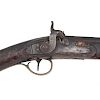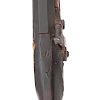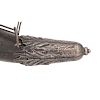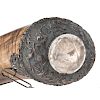John James Audubon’s Favorite “Long Tom” Fowler, Descended Directly through the Family of His Wife Lucy Bakewell Audubon
About Seller
6270 Este Ave.
Cincinnati , OH 45232
United States
With offices in Cincinnati, Cleveland and Denver, Cowan’s holds over 40 auctions each year, with annual sales exceeding $16M. We reach buyers around the globe, and take pride in our reputation for integrity, customer service and great results. A full-service house, Cowan’s Auctions specializes in Am...Read more
Two ways to bid:
- Leave a max absentee bid and the platform will bid on your behalf up to your maximum bid during the live auction.
- Bid live during the auction and your bids will be submitted real-time to the auctioneer.
Bid Increments
| Price | Bid Increment |
|---|---|
| $0 | $25 |
| $500 | $50 |
| $1,000 | $100 |
| $2,000 | $250 |
| $5,000 | $500 |
| $10,000 | $1,000 |
| $20,000 | $2,500 |
| $50,000 | $5,000 |
| $100,000 | $10,000 |
About Auction
Oct 6, 2018
The Americana, Including Fine and Decorative Art: Premier Auction features over 500 lots of fine art, furniture, silver, rugs, glass, Folk Art, timepieces, and advertising. Cowan's Auctions dawnie@cowans.com
- Lot Description
Exceptionally long percussion fowling piece, with untouched figured maple stock and checkered wrist, fitted with brass buttplate, ramrod pipes, and engraved, “pineapple” style trigger guard, lacking brass fore-end cap. Smoothbore, 60 Caliber, 57.25 in. octagonal-to-round barrel with untouched deep even age brown patina and brass bead front sight. British proof marks on breech. The lock converted from flintlock to percussion, with lockplate marked "Galton.” Lacking one barrel pin, another replaced with a wooden plug. Evidence of sling swivel mounting on bottom comb of stock.
Affixed to the left cheek plate of the stock is a heavy gage, 5 x 1 in. brass plaque with the following inscription in block letters:
The gun is the original “Long Tom” of John James Audubon. At his death, his widow, Mrs. Lucy Bakewell Audubon gave the gun to her brother William Gifford Bakewell. This statement is testified to by Mrs. William G. Bakewell and Miss Harriet Bachman Audubon, granddaughter of J.J. Audubon.
The gun is offered with a traditional Scottish flattened ornamental powder horn, approximately 11 in. in length, richly decorated with silver fittings cast and chased with Scottish thistles at the spout, midpoint and butt. The butt originally inset with a faceted glass cairngorm (present but loose and chipped). The horn additionally ornamented with a small silver plaque engraved: Presented to J.J. Audubon. By Natural History Society Edinburg 1827. With three silver rings for a silver shoulder strap.
Audubon and His Life in the Ohio Valley
Audubon, John James (1785-1851). French-American hunter, naturalist, painter and ornithologist best known for his iconic masterpiece The Birds of America. Audubon’s “Long Tom,” an English flintlock wildfowling gun, and his presentation powder horn are directly descended from Audubon to the present owner.
Born in 1785 on his father’s sugar plantation in Les Cayes, Saint Domingue (present-day Haiti), John James Audubon’s given name was Jean Rabin. He was the son of a prosperous French naval officer, Jean Audubon, and his mistress, Jeanne Rabin, who died within months of her son's birth. Due to rising slave tensions on the island, Jean Audubon determined that his young son and another illegitimate child should be relocated to France. The children settled near Nantes, France, where they were raised by Audubon and his French wife, Anne Moynet. The young Jean Rabin was formally adopted by the Audubons and his name was changed to Jean-Jacques Audubon. It was the naturalist and ornithologist himself who adopted the name by which we know him today, choosing to Anglicize his name to John James Audubon when he embarked for America in 1803.
While Audubon ostensibly left France to manage land owned by his father at Mill Grove in Pennsylvania, the move was likely initiated to keep John James from being conscripted into Napoleon’s army. Audubon was immediately captivated by the natural wildlife he encountered, and particularly with the birds that flourished in the Pennsylvania wilderness. He was also enchanted by the daughter of one of his neighbors. After a lengthy courtship, he married Lucy Green Bakewell (1787-1874) in 1808. The young couple moved first to Louisville then to Henderson, Kentucky. Operating as a merchant and a miller, Audubon’s business fortunes rose and then fell precipitously during the next decade. Through it all, however, he maintained a passion for wildlife and for sketching. “I seldom passed a day without drawing a bird, or noting something respecting its habits…,” Audubon later wrote of his time in Kentucky.
In the winter of 1819, Audubon was given a much-needed opportunity to improve his finances. Dr. Daniel Drake, a well-respected physician with an interest in natural history, invited Audubon to Cincinnati to work at the newly established Western Museum Society, a precursor to the current Cincinnati Museum of Natural History. Dr. Drake envisioned the Society as a conduit to present western natural history to the public, and he employed Audubon as the museum’s first taxidermist. Audubon was also tasked with painting exhibit backgrounds. Drake was one of the earliest to recognize the significance and quality of Audubon’s work, and went so far as to present a display of his taxidermist’s bird paintings, which was recognized by the Cincinnati Inquisitor Advertiser as having style and execution so superior that “…Good judges have indeed declared they excel all other similar works in the United States.”
Audubon embarked from Cincinnati in October 1820 on a journey down the Ohio and Mississippi Rivers to Louisiana. Still plagued by financial difficulties, he now relied fully on his artistic talent to make a living painting portraits and teaching drawing. Most consequentially though, his time along the frontier and in Louisiana saw Audubon focus explicitly on building his portfolio with the intent of assembling a comprehensive collection of North American birds for publication. By 1824, Audubon was actively seeking publication in the United States for his work. Unsuccessful, he sailed for England in 1826 where upon arrival he began courting wealthy patrons and members of the scientific community.
It was here in England that at last Audubon received the recognition, financial backing, and technical support that would launch his career. Audubon was perceived as the incarnation of a vast and romanticized American frontier. His bird paintings, life-like in size, with the species depicted in their natural habitats, were a revelation. Audubon was accepted into the drawing rooms of the elite and into the meeting rooms of the island’s most learned men. By 1827, the first plates of Audubon’s The Birds of America were being published. Once little-known and near destitute, John James Audubon soon cemented his legacy as an artist, naturalist and ornithologist in England and the United States.
History and Provenance of Audubon’s “Long Tom” Fowling Rifle and Presentation Powder Horn
Audubon’s fowling rifle – known universally by bird hunters of the 19th century as a “Long Tom” for its characteristically long barrel – was manufactured in Britain sometime in the last half of the 18th century. While the barrel is touched with English proof marks, the rest of the barrel is unmarked. Originally designed as a flintlock, at some point in its history the rifle was converted to percussion, retaining its original lock plate stamped “Galton.”
At least three Galtons (probably all related) were active in London and Birmingham, England from the mid 18th century through the mid-19th century, though it is not possible to determine which of the relatives made the rifle. The fowler was likely converted from flint to percussion sometime in the 1840s – the heyday of percussion rifles in the United States.
Audubon would have owned many guns during his lifetime. In addition to this hunting fowler, at least two other guns previously owned by Audubon are known to exist. One shotgun resides in the collections of the American Museum of Natural History in New York and a muzzle-loading percussion-cap shotgun is held in special collections at the Princeton University Library. The fowler offered here is believed to be the only Audubon gun in private hands, and is impeccably documented.
Throughout his frontier travels and early business ventures, Audubon relied upon his guns for safety, to provide food for his family, and to shoot the bird specimens that filled The Birds of America. Though Cowan’s cannot definitively document to what extent Audubon’s “Long Tom” hunting fowler was used for birds associated with The Birds of America, it is likely that many, if not most, of the birds depicted in this seminal work were taken with this gun. References to Audubon’s “Long Tom” are found in the journal of John James Audubon as well as in Audubon family records, firmly establishing the gun as a well-used and favorite firearm of the naturalist during the critical years in which he prepared early drawings for The Birds of America.
An early reference to Audubon’s “Long Tom” appears as an entry in his journal. Here he relates an 1819 incident in which “Long Tom” was wielded by his carpenter to fend off a mob attack in Henderson, Kentucky. More significantly, family records attest to the fact that this gun was in Audubon’s possession while in Henderson. A copy of a July 7, 1904, Statement of the long gun belonging to John J. Audubon accompanies this gun. The statement was authored by Martha Dillingham Bakewell (1830-1918) and states in part: The long gun wh’ I gave my son-in-law Frank Shaffer was Mr. Audubon’s favorite hunting gun, & is of very fine maker & cost his father a great deal. He brought it to John J. the naturalist from Paris – When living in Henderson Kentucky the country people called him “That crazy Frenchman with his long gun.” While it cannot be determined with certainty, it is possible that Audubon received this gun from his father in 1805 when he returned to France to handle business matters and ask permission to marry Lucy Bakewell.
Martha Bakewell’s same statement also identifies when Audubon passed his favorite gun to the next family member: “When Mr. Audubon by the advice of friends decided to make his amateur collection complete & of commercial value he went to England to solicit subscriptions to the work – That was the time he gave his favorite long gun, he had used so long, & with wh’ he had collected the most of his specimens to his favorite brother in law & companion Wm. G. Bakewell, my dear noble husband.” Martha Bakewell’s statement concludes with a reference to a key attribute of this gun – that it was altered from a flintlock to a percussion lock. “Originally, it was of course equipped with a flint lock, but in later years Mr. Bakewell had it altered & fitted with a percussion lock. M. D. Bakewell.”
Family members were not alone in noting the affinity that Audubon had for his “Long Tom.” Spencer Fullerton Baird, a naturalist and ornithologist who would one day be appointed the first curator of the Smithsonian Institution, was mentored by Audubon in the early 1840s. In a letter of February 8, 1842, Baird wrote to Audubon about a hunting expedition in which he successfully shot “a poor Golden eye, who unaware of its proximity to a second ‘Long Tom’ came flying calmly up stream….” It is believed that Baird named his own gun “Long Tom” after Audubon’s favorite firearm.
At some point in the history of the gun, a brass plate was added to Audubon’s hunting fowler. The inscription on this plate reads: “This gun is the original ‘Long Tom’ of John James Audubon. At his death his widow, Mrs. Lucy Bakewell Audubon, gave the gun to her brother, William Gifford Bakewell. This statement is testified to by Mrs. William Gifford Bakewell and Miss Harriet Bachman Audubon, granddaughter of John James Audubon.” Interestingly, this inscription indicates that the gun was given to William Gifford Bakewell at Audubon’s death and not upon his departure for England. Nonetheless, while the timing of the handover may be in question, the line of descent of the gun is not.
Like the hunting fowler, Audubon’s powder horn was given to William Gifford Bakewell and descended through his family. The powder horn, however, has a unique history all its own. It was presented to Audubon in 1827 by the Wernerian Natural History Society, a prestigious learned society founded in Edinburgh, Scotland. The Wernerian Society hosted notable scientists of the day and allowed them to present papers on their research. Significantly, members of this organization were more than just fellow scientists and naturalists. They were crucial to Audubon’s success. Presenting papers to the Wernerian Society helped Audubon gain acceptance into England’s scientific community, and it was Wernerian Society member Patrick Neill that introduced Audubon to the famed engraver William H. Lizars.
Memoirs of the Wernerian Natural History Society indicate that on December 16, 1826, a paper prepared by Audubon on the turkey buzzard was read, and, “Mr. Audubon being present, afterwards shewed to the Society his mode of fixing recently killed birds in various attitudes….” (Also present at that meeting was another scientist who would later make a name for himself, a young Charles Darwin.) Audubon was made a member of the Society by acclamation on the 16th. On January 13, 1827, John James Audubon, Esq. Louisiana was fully invested as a “Foreign” member of the Society and likely received this powder horn on that same day. A silver nameplate on the horn reads “Presented to J. J. Audubon - By - Natural History Society / Edinburg 1827.”
Line of Descent
The rifle and powder horn have an unbroken line of descent from John James Audubon to the present owner.
John James Audobon (1785–1851)
William Gifford Bakewell (1799-1871), brother-in-law of John James Audobon
Maria Dillingham Bakewell (1830-1918), wife of William Gifford Bakewell
Frank Holmes Shaffer (1857-1936), son-in-law of Maria Dillingham Bakewell
Alicia Bakewell Shaffer (1862-1940), daughter of William Gifford Bakewell & wife of Frank Holmes Shaffer
William Bakewell Shaffer (1899-1980), son of Alicia Bakewell Shaffer
Current Owner, grandson of William Bakewell Shaffer
Exhibition History
The hunting fowler and powder horn were included in the J. B. Speed Memorial Museum’s 1935 exhibition John James Audubon. The exhibition catalog indicates that the gun and powder horn were Loaned by Mrs. Frank Shaffer (Alicia Bakewell). The objects were also loaned by the family in 1985 for the Audubon in Cincinnati exhibit at Cincinnati’s Museum of Natural History & Science.
Acknowledgments
The Fine and Decorative Arts Staff gratefully acknowledges our colleagues Emily Jansen Payne, American History Specialist, and Jack Lewis, Director of Firearms & Militaria, for their contributions to this essay.
Provenance: Descended directly from John James Audubon and Family. - Shipping Info
-
Buyers are required to pay for all packing, shipping and insurance charges. Overseas duty charges are the responsibility of the successful Bidder. Be aware that for larger and/or valuable items, shipping charges can be substantial. - If there is no shipping amount on listed your invoice, you will need to make arrangements to pick up or ship your purchase through an alternative shipping company. Our shipping department can be contacted at 513.871.1670 (ext. 219) or email shipping@cowans.com. - Shipping charges include insurance for your order while in transit. If you have private insurance we will adjust your charge to include only packing and shipping. - Please allow 14 – 21 days after payment to package and ship your purchase as carefully as possible.
-
- Buyer's Premium



 EUR
EUR CAD
CAD AUD
AUD GBP
GBP MXN
MXN HKD
HKD CNY
CNY MYR
MYR SEK
SEK SGD
SGD CHF
CHF THB
THB


































